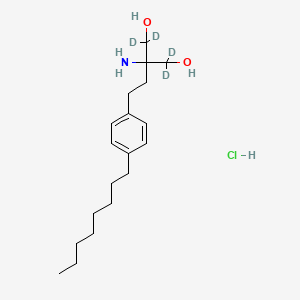
Fingolimod-d4 Hydrochlorid
Übersicht
Beschreibung
Fingolimod-D4 Hydrochloride is a labelled analogue of Fingolimod. Fingolimod is an immunosuppressive agent used for the treatment of relapsing multiple sclerosis. It is a sphingosine-1-phosphate receptor modulator preventing lymphocyte emigration to participate in the autoimmune reaction.
Wissenschaftliche Forschungsanwendungen
Quantifizierung in menschlichem Plasma
Fingolimod-d4 Hydrochlorid wird bei der Entwicklung analytischer Methoden zur Quantifizierung von Fingolimod und seinem Metaboliten Fingolimod-Phosphat im menschlichen Plasma verwendet {svg_1}. Dies ist besonders nützlich, um die interindividuellen Unterschiede in der Bioverfügbarkeit dieser Verbindungen zu bewerten und diese Unterschiede mit der Variabilität der klinischen Ansprechraten in Beziehung zu setzen {svg_2}.
Stabilitätsindizierende UPLC-Methode
this compound wird bei der Entwicklung einer stabilitätsindizierenden UPLC-Methode zur quantitativen Bestimmung von Fingolimod-Hydrochlorid und seinen verwandten Substanzen verwendet {svg_3}. Diese Methode ist nützlich für die Analyse von pharmazeutischen Wirkstoffen und pharmazeutischen Darreichungsformen {svg_4}.
Behandlung der Multiplen Sklerose
this compound wird zur Behandlung der schubförmig-remittierenden Multiplen Sklerose eingesetzt {svg_5}. Es ist ein Sphingosin-1-Phosphat-Rezeptor-Modulator, der die Anzahl der Schübe bei Patienten mit dieser Form der Multiplen Sklerose reduzieren kann {svg_6}.
Antitumoraktivität
this compound hat eine potenzielle Antitumoraktivität gezeigt {svg_7}. Es aktiviert die Proteinphosphatase 2A, was zu Antitumoreffekten führt {svg_8}. Die Entwicklung von Fingolimod-Analoga, die nicht phosphoryliert werden können, wird erforscht, um die Antitumoraktivität zu verbessern {svg_9}.
Behandlung von Psychosen
this compound wurde zur Behandlung von psychosebedingtem Verhalten verwendet {svg_10}. Es wurde gezeigt, dass es die Methamphetamin-Hypersensitivität lindert und Maßnahmen der Neuroinflammation wie Mikrogliazell-Aktivierung, Zytokinproduktion und Leukozyteninfiltration verbessert {svg_11}.
Förderung der Angiogenese
this compound wurde verwendet, um die Angiogenese zu fördern {svg_12}. Es wurde gezeigt, dass es die Osteoinduktivität maximiert und die Einarbeitung von Allotransplantaten verbessert, indem Knochenvorläuferzellen aus dem umliegenden Weichgewebe und der Mikrozirkulation rekrutiert werden {svg_13}.
Wirkmechanismus
Target of Action
Fingolimod-d4 Hydrochloride, also known as FTY720-d4 Hydrochloride, primarily targets the sphingosine 1-phosphate receptors (S1PRs) found on lymphocytes and other organs . The modulation of these receptors is crucial in managing multiple sclerosis (MS) symptoms .
Mode of Action
Fingolimod-d4 Hydrochloride acts as a sphingosine 1-phosphate receptor modulator . It is metabolized to its active form, fingolimod-phosphate, which binds to sphingosine 1-phosphate receptors 1, 3, 4, and 5 .
Biochemical Pathways
Fingolimod-d4 Hydrochloride affects several biochemical pathways. It induces metabolic reprogramming in brain regions, upregulating oxidative phosphorylation while downregulating glycolysis and the pentose phosphate pathway . It also modulates neuroinflammation by upregulating retrograde endocannabinoid signaling and autophagy pathways, and downregulating neuroinflammation-related pathways including neutrophil degranulation and the IL-12 mediated signaling pathway .
Pharmacokinetics
It’s known that the compound is given orally . More research is needed to fully understand the ADME properties of Fingolimod-d4 Hydrochloride and their impact on bioavailability.
Result of Action
The molecular and cellular effects of Fingolimod-d4 Hydrochloride’s action are profound. It reduces the number of lymphocytes in the peripheral blood, which is believed to be effective in treating MS due to the reduced lymphocytes into the CNS . It also induces numerous biological effects, including endothelial cell-cell adhesion, angiogenesis, vascular integrity, and cardiovascular function .
Action Environment
The action environment of Fingolimod-d4 Hydrochloride is primarily within the immune system and the CNS . The interaction with s1p receptors in various tissues accounts for the reported adverse effects
Biochemische Analyse
Biochemical Properties
Fingolimod-d4 Hydrochloride interacts with sphingosine 1-phosphate receptors (S1PRs) to bring about an array of pharmacological effects . It exerts inhibitory effects on sphingolipid pathway enzymes, inhibits histone deacetylases, transient receptor potential cation channel subfamily M member 7 (TRMP7), cytosolic phospholipase A2α (cPLA2α), reduces lysophosphatidic acid (LPA) plasma levels, and activates protein phosphatase 2A (PP2A) .
Cellular Effects
Fingolimod-d4 Hydrochloride has profound effects on various types of cells and cellular processes. It can profoundly reduce T-cell numbers in circulation and the CNS, thereby suppressing inflammation and MS . It also induces apoptosis, autophagy, cell cycle arrest, epigenetic regulations, macrophages M1/M2 shift and enhances BDNF expression .
Molecular Mechanism
Fingolimod-d4 Hydrochloride exerts its effects at the molecular level through several mechanisms. It binds to S1P receptor4 (S1PR4) that is primarily expressed in lymphocytes and hematopoietic tissues . It can induce apoptotic pathways by activation of caspase cascades, enhancing PTEN which inhibits pAkt, and inducing (ROS-JNK-p53) loop-dependent autophagy .
Temporal Effects in Laboratory Settings
It has been shown that the drug has a significant therapeutic effect in immunodeficient mice, not in immunocompetent mice .
Dosage Effects in Animal Models
In an animal model of genetic absence epilepsy, Fingolimod (1 mg/kg) showed transient antiepileptic effects and longer-lasting anti-cognition decline . During the chronic epileptic phase of the mouse kainate model, 6 mg/kg of the drug also showed neuroprotective and anti-gliotic effects besides reducing seizure frequency .
Metabolic Pathways
Fingolimod-d4 Hydrochloride is involved in the sphingosine 1-phosphate (S1P) pathway . It is phosphorylated to Fingolimod-phosphate by two protein kinases, type-1 and type-2 sphingosine kinase (SphK1 and -2), enabling it to interact with sphingosine receptors .
Transport and Distribution
It is known that Fingolimod binds to S1P receptor4 (S1PR4) that is primarily expressed in lymphocytes and hematopoietic tissues .
Subcellular Localization
It is known that Fingolimod activates PP2A that plays a principal role as a regulator of cell cycle/division and growth .
Eigenschaften
IUPAC Name |
2-amino-1,1,3,3-tetradeuterio-2-[2-(4-octylphenyl)ethyl]propane-1,3-diol;hydrochloride | |
|---|---|---|
| Source | PubChem | |
| URL | https://pubchem.ncbi.nlm.nih.gov | |
| Description | Data deposited in or computed by PubChem | |
InChI |
InChI=1S/C19H33NO2.ClH/c1-2-3-4-5-6-7-8-17-9-11-18(12-10-17)13-14-19(20,15-21)16-22;/h9-12,21-22H,2-8,13-16,20H2,1H3;1H/i15D2,16D2; | |
| Source | PubChem | |
| URL | https://pubchem.ncbi.nlm.nih.gov | |
| Description | Data deposited in or computed by PubChem | |
InChI Key |
SWZTYAVBMYWFGS-JWIOGAFXSA-N | |
| Source | PubChem | |
| URL | https://pubchem.ncbi.nlm.nih.gov | |
| Description | Data deposited in or computed by PubChem | |
Canonical SMILES |
CCCCCCCCC1=CC=C(C=C1)CCC(CO)(CO)N.Cl | |
| Source | PubChem | |
| URL | https://pubchem.ncbi.nlm.nih.gov | |
| Description | Data deposited in or computed by PubChem | |
Isomeric SMILES |
[2H]C([2H])(C(CCC1=CC=C(C=C1)CCCCCCCC)(C([2H])([2H])O)N)O.Cl | |
| Source | PubChem | |
| URL | https://pubchem.ncbi.nlm.nih.gov | |
| Description | Data deposited in or computed by PubChem | |
Molecular Formula |
C19H34ClNO2 | |
| Source | PubChem | |
| URL | https://pubchem.ncbi.nlm.nih.gov | |
| Description | Data deposited in or computed by PubChem | |
Molecular Weight |
348.0 g/mol | |
| Source | PubChem | |
| URL | https://pubchem.ncbi.nlm.nih.gov | |
| Description | Data deposited in or computed by PubChem | |
Synthesis routes and methods I
Procedure details





Synthesis routes and methods II
Procedure details







Retrosynthesis Analysis
AI-Powered Synthesis Planning: Our tool employs the Template_relevance Pistachio, Template_relevance Bkms_metabolic, Template_relevance Pistachio_ringbreaker, Template_relevance Reaxys, Template_relevance Reaxys_biocatalysis model, leveraging a vast database of chemical reactions to predict feasible synthetic routes.
One-Step Synthesis Focus: Specifically designed for one-step synthesis, it provides concise and direct routes for your target compounds, streamlining the synthesis process.
Accurate Predictions: Utilizing the extensive PISTACHIO, BKMS_METABOLIC, PISTACHIO_RINGBREAKER, REAXYS, REAXYS_BIOCATALYSIS database, our tool offers high-accuracy predictions, reflecting the latest in chemical research and data.
Strategy Settings
| Precursor scoring | Relevance Heuristic |
|---|---|
| Min. plausibility | 0.01 |
| Model | Template_relevance |
| Template Set | Pistachio/Bkms_metabolic/Pistachio_ringbreaker/Reaxys/Reaxys_biocatalysis |
| Top-N result to add to graph | 6 |
Feasible Synthetic Routes
Haftungsausschluss und Informationen zu In-Vitro-Forschungsprodukten
Bitte beachten Sie, dass alle Artikel und Produktinformationen, die auf BenchChem präsentiert werden, ausschließlich zu Informationszwecken bestimmt sind. Die auf BenchChem zum Kauf angebotenen Produkte sind speziell für In-vitro-Studien konzipiert, die außerhalb lebender Organismen durchgeführt werden. In-vitro-Studien, abgeleitet von dem lateinischen Begriff "in Glas", beinhalten Experimente, die in kontrollierten Laborumgebungen unter Verwendung von Zellen oder Geweben durchgeführt werden. Es ist wichtig zu beachten, dass diese Produkte nicht als Arzneimittel oder Medikamente eingestuft sind und keine Zulassung der FDA für die Vorbeugung, Behandlung oder Heilung von medizinischen Zuständen, Beschwerden oder Krankheiten erhalten haben. Wir müssen betonen, dass jede Form der körperlichen Einführung dieser Produkte in Menschen oder Tiere gesetzlich strikt untersagt ist. Es ist unerlässlich, sich an diese Richtlinien zu halten, um die Einhaltung rechtlicher und ethischer Standards in Forschung und Experiment zu gewährleisten.
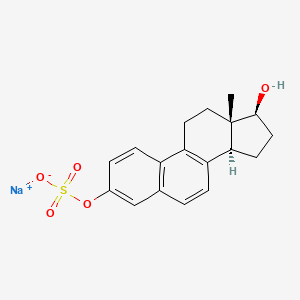
![2-[4,7-Bis(carboxylatomethyl)-1,4,7,10-tetrazacyclododec-1-yl]acetate;gadolinium(3+)](/img/structure/B602385.png)
![13,17-dihydroxy-4-methyl-14-methylidene-5-oxo-6-oxapentacyclo[11.2.1.14,7.01,10.03,9]heptadec-8-ene-2-carboxylic acid](/img/structure/B602386.png)
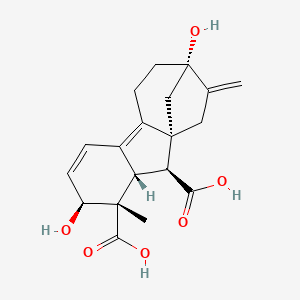


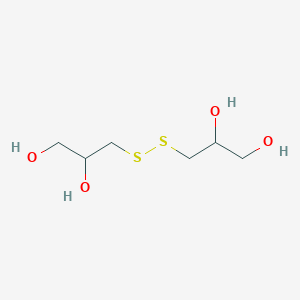
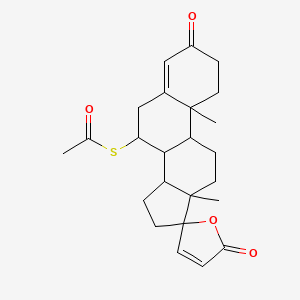


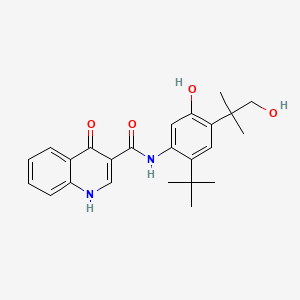
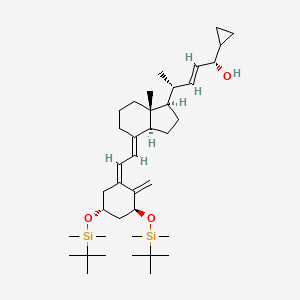
![(2E,4R)-4-[(1R,3aS,4E,7aR)-4-[(2E)-2-[(3S,5R)-3,5-Bis[[(tert-butyl)dimethylsilyl]oxy]-2-methylenecyclohexylidene]ethylidene]octahydro-7a-methyl-1H-inden-1-yl]-1-cyclopropyl-2-penten-1-one](/img/structure/B602404.png)
